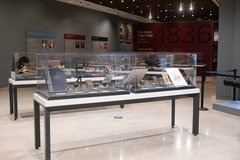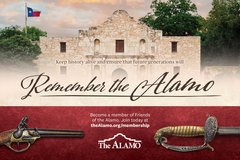Archaeological work conducted by Pape Dawson resumed within Crockett and Bonham Streets as part of the Phase I of the Alamo Plan this week. Workers continued to remove the foundation of the Lady Bird Johnson fountain that was returned to its donors. The foundation extended to approximately 3 feet below the surface in areas. The foundation removal should be finished by the end of July.
Archaeology Update — Phase 1 Work Resumes on Crockett & Bonham Streets

For archaeological monitoring, much of the work consisted of the observation of water line realignments within the street, with short lateral connections off the main line to feeder lines for hydrants. Prior to the trench excavations, the pavers along the street had been removed, revealing a layer of asphalt and concrete extending approximately 21 inches below surface in some areas. Below that, the trench exhibited fill soils with high gravel content. It does not appear that any native soils were present in the excavation trench associated with the water line. The trench excavation varied in depth throughout the length, reaching depths minimum depths of 4 feet below the surface, with a few sections up to 10 feet below the surface.

One section of the trench crossed the projected alignment of an acequia. “Acequia” is the Spanish word for irrigation ditch, which would have been used throughout the mission period to divert water into the fields. In this case, this acequia originated from the San Antonio River, near the present-day Witte Museum.
The ditch traveled south, breaking off into several branches, with this branch located on the exterior of the Mission Valero compound, just east of the Church. Examination of the trench wall profiles did not reveal evidence of the acequia. It is likely that previous construction activities and the installation of the various utilities in Crockett Street had removed any evidence of the ditch in this area.

Raba Kistner has continued investigations within the Alamo Church as well, with the exhumation of known burials and continuation of the test units to allow for the installation of the sensors for monitoring the conditions below ground. As the exhumation process has progressed, bioarchaeologists have encountered additional remains within the excavation units. Once the General Land Office and the Texas Historical Commission Archaeology Division were notified, bioarchaeologists continued to delineate these new burials and complete the exhumations according to the methods and practices presented in the research design. All human remains recovered from the current efforts have been carefully removed and stored in the Alamo Curation Vault for a short period of time until reburial of all remains can occur, per the previously established Human Remains Protocol set in place for this project. The archaeological team has communicated to all parties outlined in the Human Remains Protocol the current progress of the investigations. To date of the update publication, the archaeologists have finished exhumations and excavations in three of the four units.
As these investigations have progressed, artifacts have been recovered consisting of animal bone, ceramics, brick, and a few other specific items. A couple items of interest, associated with the the exhumations, included a bone buttons and a lead shot. Bone buttons are consistent with the handmade variety that is noted at many historical sites in Texas. Buttons would have been fashioned by using a button drill on flat animal bone. Most early handmade buttons have variations in size and placement of holes.
Lead shot would have been brought to the site by the Spanish in 1724, when the mission moved to the final location. Firearms using lead shot persisted well into the Civil War period, with the percussion cap gaining popularity during this time period.
Archaeological investigations will continue over the next several weeks, with the archaeological excavations associated with the preservation work in the Church likely wrapping up before the end of August.


